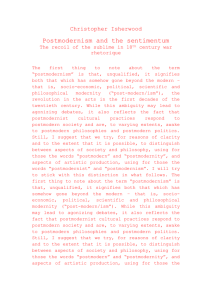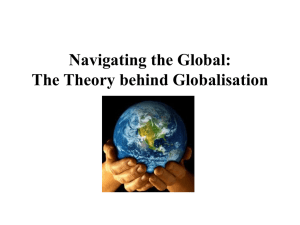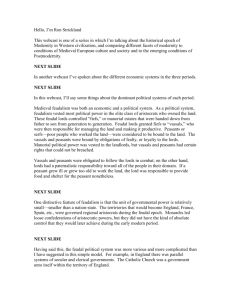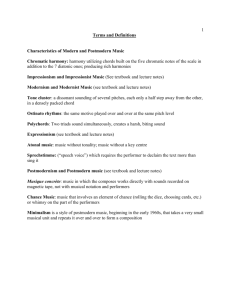Postmodernity – what about Toys
advertisement
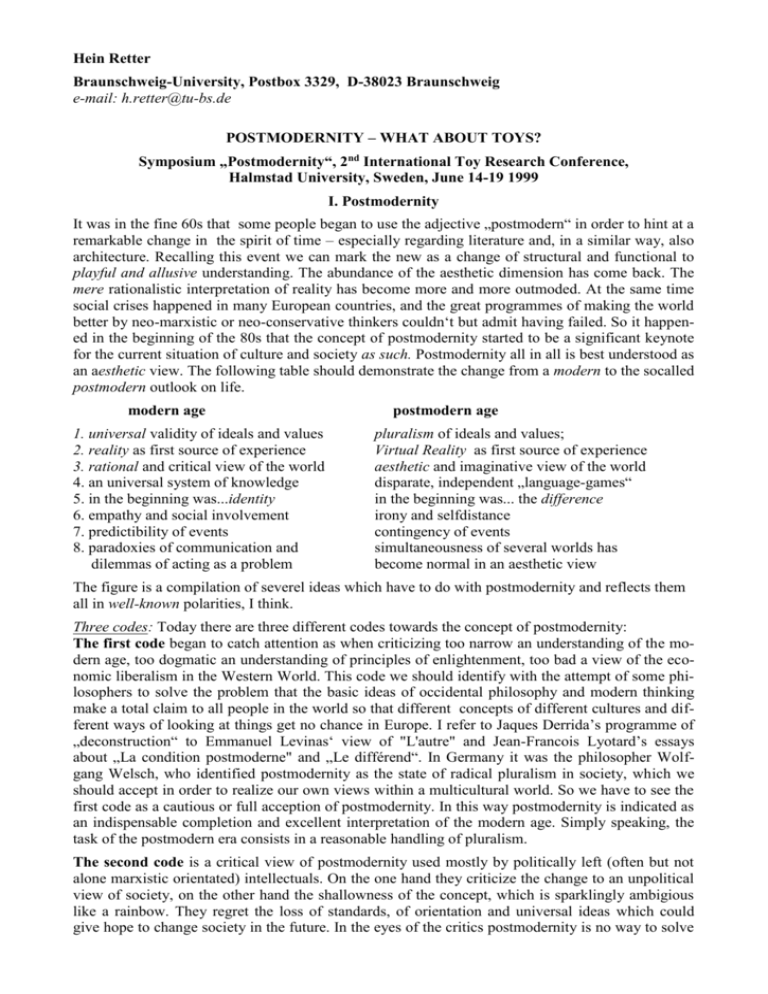
Hein Retter Braunschweig-University, Postbox 3329, D-38023 Braunschweig e-mail: h.retter@tu-bs.de POSTMODERNITY – WHAT ABOUT TOYS? Symposium „Postmodernity“, 2nd International Toy Research Conference, Halmstad University, Sweden, June 14-19 1999 I. Postmodernity It was in the fine 60s that some people began to use the adjective „postmodern“ in order to hint at a remarkable change in the spirit of time – especially regarding literature and, in a similar way, also architecture. Recalling this event we can mark the new as a change of structural and functional to playful and allusive understanding. The abundance of the aesthetic dimension has come back. The mere rationalistic interpretation of reality has become more and more outmoded. At the same time social crises happened in many European countries, and the great programmes of making the world better by neo-marxistic or neo-conservative thinkers couldn‘t but admit having failed. So it happened in the beginning of the 80s that the concept of postmodernity started to be a significant keynote for the current situation of culture and society as such. Postmodernity all in all is best understood as an aesthetic view. The following table should demonstrate the change from a modern to the socalled postmodern outlook on life. modern age 1. universal validity of ideals and values 2. reality as first source of experience 3. rational and critical view of the world 4. an universal system of knowledge 5. in the beginning was...identity 6. empathy and social involvement 7. predictibility of events 8. paradoxies of communication and dilemmas of acting as a problem postmodern age pluralism of ideals and values; Virtual Reality as first source of experience aesthetic and imaginative view of the world disparate, independent „language-games“ in the beginning was... the difference irony and selfdistance contingency of events simultaneousness of several worlds has become normal in an aesthetic view The figure is a compilation of severel ideas which have to do with postmodernity and reflects them all in well-known polarities, I think. Three codes: Today there are three different codes towards the concept of postmodernity: The first code began to catch attention as when criticizing too narrow an understanding of the modern age, too dogmatic an understanding of principles of enlightenment, too bad a view of the economic liberalism in the Western World. This code we should identify with the attempt of some philosophers to solve the problem that the basic ideas of occidental philosophy and modern thinking make a total claim to all people in the world so that different concepts of different cultures and different ways of looking at things get no chance in Europe. I refer to Jaques Derrida’s programme of „deconstruction“ to Emmanuel Levinas‘ view of "L'autre" and Jean-Francois Lyotard’s essays about „La condition postmoderne" and „Le différend“. In Germany it was the philosopher Wolfgang Welsch, who identified postmodernity as the state of radical pluralism in society, which we should accept in order to realize our own views within a multicultural world. So we have to see the first code as a cautious or full acception of postmodernity. In this way postmodernity is indicated as an indispensable completion and excellent interpretation of the modern age. Simply speaking, the task of the postmodern era consists in a reasonable handling of pluralism. The second code is a critical view of postmodernity used mostly by politically left (often but not alone marxistic orientated) intellectuals. On the one hand they criticize the change to an unpolitical view of society, on the other hand the shallowness of the concept, which is sparklingly ambigious like a rainbow. They regret the loss of standards, of orientation and universal ideas which could give hope to change society in the future. In the eyes of the critics postmodernity is no way to solve 2 such problems but a self-satisfied kind to culti- vate them, a rollback to premodern epochs, anything but appropriate to our difficult situation today. When theories of modern age not only praised the progress of science and social welfare, but described the danger of human self destruction and alienation then German critics like Jürgen Habermas warned of the belief in postmodernity as a confused concept which can‘t solve the problems of the next millenium. The third code offers us a mixture of helplessness, despairing moral opposition or ironic views as a reaction to the change of society on the way to conquer the media totally by entering the Virtual Reality, that means computer simulated every-day-life. One small group regrets the process of "mediatization". They have created the well-known language-game of "disappearance“: the disappearance of reality, the disappearance of childhood, the disappearance of imagination and last not least the disappearance of education. You see: not Killroy, but Postman was here (what a suggestive name!) A second (larger) group doesn‘t use a moralized undertone in their ideas like Postman, but is also free from illusions of a better world. For them the often used slogan „Anything goes!“ is not a subject of criticism, but rather a restrained ironic description of things which happen, and a call on doing so also. Who can, can! Every man has his own problems. For instance: If you live in Kosovo your world is the war, my world is to see you in the TV-pictures, and if there should be a rest of moral obligation I give some money for you. That’s all. Another example: Let us reflect on the role of conferences, for instance this conference at the level of postmodern thinking. In the modern view such a conference is very important because researchers spread out scientific results about children, their play and their toys - worldwide. The postmodern view says to us ironically: You know, conferences like this are staged happenings, nothing else, with the welcome of the president at the beginning, the honouring of a person with some merits by an award in the middle, and the general meeting with the modest rest of participants at the end of the conference. Our feeling must be good, and naturally it is, that’s why the organization is excellent. Nevertheless what people say in their lectures is determined to be forgotten, the more people tell their stories, the more the stories will equalize each other and become unimportant. Therefore the main motivation to come to the conference is to see some old friends and to drink a glass of wine with them in the evening. By the way: many or even most of them - of the lecturers here - are grandparents. To give an example for the third code in the contemporary literature I should like to mention the book of Michel Houellebecq „Extension du Domaine de la Lutte“ (Paris 1994): A young computer specialist describes his experience that attractiveness is the only value in the modern view of life; his problem is not being attractive, that means to be constantly unsuccessful with women. Yearning, isolation, ideas of self-mutilization are described by the author not in an ironical way, but in a crystal-clear view without any hope to find a way out. It’s no accident but a sign of our time that in France this small volume was given two literary awards.The following analysis of children's play and the role of toys opens the chance to draw conclusions on the background of the described different codes of understanding postmodernity. II. Children’s play The situation of families in Germany - some data: We begin with some statistical data about the situation of the postmodern family. Sociological research has collected a lot of results to demonstrating the change of socialization within the change of family-structure in the last decades. Instead of a detailed report I give short statements to illustrate the situation: 1. The average age of people who get married has increased dramatically in the last 15 years: year male female 1985 26.6 24.1 1996 33.4 27.6 3 average age of marriage in West Germany 2. The absolute number of marriages decreases continually - both absolutely and in relation to the decreasing resp. stagnant devolopment of the population. This goes with an increasing number of unmarried partnerships. The absolute numbers of marriages were (East and West Germany together): 1970 575,233 1990 516,388 1996 427,297 number of marriages in Germany 3. The relation of divorces (175 thousand) to marriages (427 thousand) was about 40 % in 1996. This goes with an increasing number of one-parent-families after divorce or separation 4. In 1997, there were 37.5 million households in Germany, 24.2 million of which were living with at least two persons, and 11 million of which lived without children. There were 9.5 million families with children under 18. In detail: Families with 1 child Families with 2 children Families with 3 children Families with 4 or more ch. = 4.8 mio. = 50 % = 3.5 mio. = 38 % = 0.9 mio. = 9 % = 0.3 mio. = 3 % The data of family research lead to some remarkable consequences: The kinds of living together – married, unmarried or as a single parent - has become multivarious; to define the normal family becomes difficult in the postmodern time, because these cases you would have indicated as divergent in former times now you have to classify as normal cases. The most widespread condition of postmodern socialization is to grow up without any sibling; that means no sister or brother could be a model as a playmate for the younger child; The high rate of divorces and separations suggests a more complicated life of the concerned children. I think it seems well-considered to suggest that the equipment with play-materials (and other attractive things of the commercial market for children) tempts adults to use it as a chance to compensate for the bad feelings of the affected child and to relieve themselves of their own blame. Children have learned promptly to understand the games people play (E. Berne) with each other. Today children earlier attain competence in managing the own leisure-time, dates with friends and buying things from the own pocket money, which is not at all small in many families. The change of children‘s play in a changing society: In the process of the industrial society changing to a post-industrial society a social change becomes visible: Modern Western societies no longer have relatively uniform attitudes to values, social classes and forms of life, but are split up in themselves into a multitude of individual lifestyles with diverging socio-cultural contexts. This development has led not only to a change in the conditions of socialization of children and their playing activities. Also our assessment of the possible dangers which threaten children's play has become more differentiated. So we have to include in our considerations - that it is not appropriate only to add up individual endangering factors to a sum total, but that they must be combined in a complex, multi-causal network of relationships to one another; - that therefore it would be unreasonable to wish to remove the things endangering children's play through individual counter-measures, but that rather a system-theoretical attempt at analyzing the situation of children at play appears to be necessary; 4 - that the much-cited word of the "endangering of play" does not only result from a large number of restrictive ecological conditions and risk factors, but that it can also result from the unintentional side-effects of our own pedagogical counter-measures. With regard to children’s play and other activities in leisure time we have to consider the following factors of change during recent decades (I outline the situation in Germany): 1. Traditional games that children played in former times within the peer group close to the own home have disappeared to a great extent. Only in some regions with ethnic Germans such as emigrants from Eastern Europe with a high number of children in the families you may observe some play-activities in the traditional way. 2. In the past, free time was seldom planned; it occurred according to situation and actual needs. Today, free time is more organized by short-/long-term planning (dates with friends, regular appointments: sport clubs, music school, groups of children in church etc.). 3. In the past play was the main activity of children in their leisure time. Today there is a competition between play activities and the usage of media, TV, video, audio-cassettes, computer games etc. The media themselves today offer a wide range of games which children can use in an active or passive way. 4. Play was in the past mostly organized spontaneously by the children themselves. Today, offers to play are mostly granted by institutions such as kindergarten, communal group, sport clubs. 5. In the past, outdoor playgrounds were near the living areas, everywhere where playing was possible - despite traffic and other limitations; a piece of nature was also at hand in the living area; today well-equipped playgrounds are often far away from the living areas; mostly there are special play-grounds (adventure parks, chess corner for the youths and the rocking-horse for the infant in the pedestrian zone), "nature" can only be reached by car. 6. Playing indoors was possible either in one's own home or at the neighbours' homes in the past; today many mothers resp. parents go by car with their child to meet in the home or outdoors another family of the same life style, apart from this: supermarkets and department stores with their multi-media play become large indoor playgrounds for children, too. All in all children’s spontaneous unplanned play changed from outdoor to indoor play. This doesn’t mean that being outdoors has become unattracitive: Outdoor activities remain important, but they don't have much to do with play, for instance cycling or scating are often-practiced activities. 7. Children as well as adults find adventure worlds through the commercialization of spare time activities; the susceptibility to stimuli is much bigger than in earlier times; children's expectations towards life have also become greater. 8. The classical approaches to explain children's play - by psychoanalysis, anthropological studies, developmental psychology, phenomenology etc. - are completed today by other theories, in particular theories of communication, decision, action and ecology. The more the complexity of the world grows, the more the theoretical effort grows to grasp the phenomenon of play. The result is paradox: Until now play has been a well-known activity, recognizable by well-distinct shapes - classified for instance in play with objects, fantasy play and game play. However in the postmodern era everything seems to indicate that play in this definite sense begins to disappear and to dissolve into a great variety of fuzzy phenomena which often make it difficult to determine the border between play and notplay. In my opinion this is a typical effect of postmodern relationships. The main question of some worried educators and teachers was in the modern age: For which reality should we prepare children, to the virtual reality or the traditional face-to-face communication? Children of postmodernity have decided this in their leisure without problems by preferring the reality of the media- and computer world in a wide range. One reason is that in many cases adults are unimaginative. They are not able to offer a programme with the same fascination. And the problems grow for the teachers of kindergarten and primary school because they teach and educate children in a public institution, which 5 can’t turn down universal moral standards. The attempt to influence children pedagogically has three results: the catchwords are institutionalization, professionalization, expertization. As the „natural“ base of education within the family has become fragile to a great extent, an increase in institutionalizatied care for children has ensued, not only in the pre-school age. This involves taking care for the children’s play. Professionalization and expertization of play is a result of the increasing importance which we attribute to the development of abilities and interests of children. We see the paradox: professionalization and expertization of the children automatically lead to an alienation from the thought of free, self-determined play. When children play together, away from the control of adults, they are inter se, neither parents nor teachers are concerned with them. They form their own society, which also has a "private" character - this also means that the play group can form and also dissolve again spontaneously. But these natural play communities in the streets of residential areas have become rare in a time in which there is only a very thin network of individual neighbourhood relationships between children due to a lack of children. In many cases the kindergarten gets a compensating function to impart on children a different playcompetence than they acquire by computer games. In 1992, a project was set up in Munich to do this in the kindergarten without toys. The basic idea was to make children independent from commercial play-things, so that they can better resist to drug-addiction in later years. In the meantime the toyless kindergarten has grown to a serious movement in the whole country. Kindergartenteachers are to give children only some natural materials, leftover wooden materials or cardboard. Toddlers and five-year-olds should use them in their role-play or should create fantasy constructions with such scant equipment. Another variation of this idea is the kindergarten in the woods. Summer and winter, with good or bad weather, children go out for several hours in the morning to the near woods in order to explore nature, playing with all things they find there. [I interrupt the lecture to show a 5min. video of a kindergarten-group in the woods] If you consider that - on the other hand - the kid-laboratory of Lieselotte van Leeuwen in Marssen/Netherlands develops intelligent top-technology usable for children up to 4 (in a big research project of the European Union with a large number of scientists as co-workers), than you may imagine the wide spectrum of different ways which are used today to support activities and abilities of children. This indicates pluralism. How do we have to evaluate the different ways and ideas, how should we say which ways are valid for us and which not? That is the question and may be discussed afterwards. But a binding „discours“ (M. Foucault) with a universal moral obligation which could tell us: this one is allright and the others all are bad for the child doesn‘t exist in postmodernity! To sum up: It would be wrong to say that the meaning of play is decreasing in the mind of the postmodern society. That’s not the point. However play and games today emerge in new contexts and get more specialized than in earlier times. In some respect tradional play has began to shrink in favour of new phenomena which some people, parents or teachers, yet resist to define as real play; particularly this holds for computer- and videogames. The traditional, educationally applied playeducation knew only play without materials (for example finger-play, round dances, catching) and play with materials, that means three dimensional objects (for example blocks and toys in the classical sense) The screen has produced a new two-dimensional kind of play. This doesn’t bring about the entire disappearance of traditional play and games, but a new balance, which has got its own contingencies: Every time may use its chance to a change and to create new kinds of play and games. III. Toys Now I'm coming to the main point of my presentation. In the postmodern society the toy market has become considerably smaller. The development is dramatical. And there is not much hope of improvement. The fading number of children is one important reason, but not the only one. It seems that the main factor is the greater attractiveness of the media, today not only TV, but also a wide range of video- and computer games. The third factor is the increasing attractiveness of many other 6 products which tempt children to buy. Producers with excellent marketing-strategies are modelling products for children as consumer, toys are in competition with them. Last but not least a fourth factor may have to do with the tendency that today childhood has many faces. The leisure-time of most middle-class children of the school-age is more structured than in former times: by obligations to use the wide market which offers to learn skills, for example in music or sports. A German/Dutch study (Bois-Reymond et al. 1994) showed: Career-minded kids at the age of 12 and their parents see playing as a matter for younger children, but not as an appropriate activity for themselves. They have a precise idea of spending the own leisure „useful“ – and that’s not playing. Fact is that the typical play-age has been reduced to the toddler- and preschool age. In January 1999 LEGO announced a staff reduction of 10 %, that means thousand jobs less. In 1998 the balance sheet of Lego showed a loss for the first time in the company history. The top management explained the unpleasant situation with the increasing attractiveness of video- and computer games in the last years (Branchenbrief international, BB extra, Jan. 26, 1999, p.1). The situation of the toy trade is similar. For instance Toys ‚R‘ US in Germany has had stagnant sales since 1995. The reason was, said the management recently, that they had trusted in the traditional toy-business for too long. Now they are introducing a new structure of the range: among them electronic products, baby clothes, accessories and outfit for teenagers (Branchenbrief international, February 26, 1999, p. 1). Some data about the economical situation of the German toy industry today: In 1998 the value of toy production in Germany decreased by 2% in comparison with the previous year (to 2.15 billion DM), the export decreased by nearly 4 % (to 1.77 billion DM), the import by 0.1% (to 3.46 billion DM). The steady decrease of toy production goes on, now in the seventh year (Branchenbrief international, May 21, 1999, p. 1). The market is full, even in video-games. The data show a clear decreasing development particularly with dolls, board-games, brick-boxes; only model-railways show an increase. In former times the German toy branch typically consisted in small and medium-sized businesses, many of them owned by families for generations. Every year in the last two decades the number of companies has become smaller, and the influence of international groups has become greater. Today the leading companies with high turnover are only 3 % of all, but they rule over three fourth of the toy sales; these are wellknown companies. I mention Mattel, Hasbro, Lego, Playmobil, Ravensburger. How is it possible that in these difficult times nevertheless some products of the toymarket are longtime bestsellers – like barbie – or are new creations with great acceptance with all customers, in particular children? My provocative thesis is: because they have nothing to do with play – in the most cases. The idea is simple: The chance of a product to be bought is a function of its attractiveness. This requires a design of high magnetism connected with the compelling desire to own it. On the other hand the child must be modelled in his or her imagination so that needs can be woken and processes of identification can happen. This requires to build up a certain fictional world which develops imaginative needs and desires. Look at Segaworld at the Picadilly in London! It is very family-friendly, a house six floors high, full of videogames and interactive games of all kinds and sizes. Children can fight here with repulsive monsters and chase other creeps; alone or by aid of family-members the child defeats the enemy. Indeed: To be powerful, to be attractive, to be intelligent and witty, to be invincible and to stand on the right side of moral, that is the pattern of entertainment industry, the pattern of films, of comics and publicity, in a certain sense the pattern of boys and men in our society. Toysystems like power rangers or „star-war“-play-figures give some impression of the consequent realization of such pattern. In comparison with boys and men, the pattern of desires for girls and women has a different profile: Beauty, friendliness, gentleness, social acceptance, sex appeal are characteristic features of the female pattern of identification. Attractiveness and bonding with the product work together. The toydesigner has only to look for an idea which is able to connect aesthetic, emotional and functional 7 aspects with a system of steady product- extension. In the case of Barbie for instance it would not help to create many sisters or brothers, the better idea was to design dresses for all situations. In the case of Lego it was consistent to open the way for toddlers by Lego-duplo and to extend the system for teenagers by introducing a variety of sets for situations of the real or the fictional world, and in addition to this to offer technical and electronics sets. But if things become too complicated, too tedious, to long-drawn-out then they reveal their borders. The postmodern world of toys must be either exciting and thrilling, or give proudness to the owner to possess a status symbol which is presentable in the peer group. This has become a main function of toys. Acting with the toy, that means to play in the traditional sense, is reduced to some manageable functions, easy to grasp and perhaps connected with some surprising effects for the lookers-on. The romantic idea that play belongs to the nature of children must be recognized as part of an imaginative construction of the adults - the idea of an historic epoch, which reaches from the romanticism to our time. In postmodernity this idea is subject to a process of deconstruction: Today welldesigned toys are no longer an universal symbol of childness, but mostly objects bonding fantasy and desire which are suitable to blur the difference between children and adults in some respect. The toy in the traditional sense only exists in particular contexts. Such particular contexts are children's activities in the kindergarten, the activities of handicapped children, the desires of children of the Third World, who are eager to get symbols of European culture and the European understanding of "childhood". Toy research has to describe these special contexts and to analyse the ideas of child's development and education from which adults derive their imaginative constructs of "play". Finally I should like to concede that one classical realm doesn’t go with my claim that playthings in postmodernity have seldom to do with play: Card- and board games. The only criterion for a good board game has always been that you must have fun while playing. To design a well-entertaining, eventful board game which at the same time opens a chance to natter with your playmates has become a science in itself. Seldom, but every now and then a boardgame-inventor is successful to do so. However only if you like to play boardgames you have the chance of experiencing this. I am happy to say that in Germany the tradition of playing board games has remained alive - in spite of postmodernity. The more adults have kept some play-competence of their childhood, the more they can use this chance. References Berne, Eric: Die Spiele der Erwachsenen. Psychologie der menschlichen Beziehungen. Reinbek 1998. Bois-Reymond, Manuela et al.: Kinderleben. Modernisierung von Kindheit im interkulturellen Vergleich. Opladen 1994. Branchenbrief international (Nostheide Verlag) Memmelsdorf b. Bamberg) Derrida, Jacques: Die Schrift und die Differenz. 7. Aufl. Frankfurt/M. 1997. Derrida, Jaqces: Grammatologie. 7. Aufl. Frankfurt/M. 1998. Einsiedler, Wolfgang: Das Spiel der Kinder. 3. Aufl. Bad Heilbrunn 1999. Foucault, Michel: Die Ordnung der Dinge. Eine Archäologie der Humanwissenschaften. Frankfurt/M. 1994. Foucault, Michel: Archäologie des Wissens. Frankfurt 1997. Foucault, Michel: Die Ordnung des Diskurses. Frankfurt 1997. Habermas, Jürgen: Theorie des kommunikativen Handelns. 2 Bde. Frankfurt 1981. Habermas, Jürgen: Vorstudien und Ergänzungen zur Theorie des kommunikativen Handelns. Frankfurt 1984. Houellebecq, Michel: Ausweitung der Kampfzone. Berlin 1997. Klotz, Heinrich: Revision der Moderne: postmoderne Architektur 1960-1980. München 1984. Levinas, Emmanuel: Die Zeit und der Andere. Hamburg 1984. Levinas, Emmanuel: Totalität und Unendlichkeit. Versuch über Exteriorität. München 1987. Levinas, Emmanuel: Humanismus des anderen Menschen. Hamburg 1989. Lyotard, Jean-Francois: Der Widerstreit. München 1987. Lyotard, Jean-Francois: Das postmoderne Wissen. Ein Bericht. 3. Aufl. Graz 1994. Lyotard, Jean-Francois. Der Enthusiasmus: Kants Kritik der Geschichte. Wien 1988. Lyotard, Jean-Francois: Das Postmoderne Wissen. Ein Bericht. Wien 1994. Postman, Neil: Das Verschwinden der Kindheit. Frankfurt/M. 1983. Retter, Hein: Die Paradoxien von Kinderspiel und Kindheit als Spiegel der Paradoxien unserer gegenwärtigen Gesellschaft. In: Neue Sammlung, 32. Jg., 1992, S. 605-617. Retter, Hein: Pädagogische Kommunikation. Bad Heilbrunn 1999. (in press) 8 Statistisches Jahrbuch für die Bundesrepublik Deutschland. Wiesbaden 1998. Welsch, Wolfgang: Unsere postmoderne Moderne. Weinheim 1987. Welsch, Wolfgang: Ästhetisches Denken. Stuttgart 1990. Welsch, Wolfgang: Wege aus der Moderne – Schlüsseltexte der Postmoderne-Diskussion. 2. Aufl. Berlin 1994.
